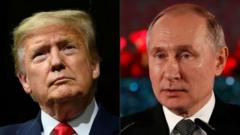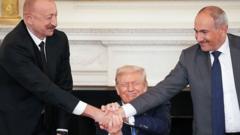As tensions escalate globally, Trump's initiative opens up discussions about the potential economic ramifications for countries involved.
**Trump’s Tariff Threat: A Game-Changer in Fueling the Global Economy Post-Russia Conflict**

**Trump’s Tariff Threat: A Game-Changer in Fueling the Global Economy Post-Russia Conflict**
US President Donald Trump proposes new secondary tariffs aimed to impact global trade dynamics, particularly with countries still engaging with Russia amidst the Ukraine crisis.
In an effort to curb Russia's financing of its ongoing war in Ukraine, President Donald Trump is set to introduce new secondary tariffs targeting nations that continue trading with Moscow. If no ceasefire agreement is reached by Friday, August 8, these tariffs will impose a hefty 100% tax on goods imported into the U.S. from any country maintaining trade relations with Russia.
Historically, Russia has withstood severe sanctions but continues to leverage its abundant energy resources to sustain military operations. Oil and gas exports are crucial for the Russian economy, with major buyers including China, India, and Turkey. “I used trade for a lot of things, but it's great for settling wars,” remarked Trump last month, signaling a renewed strategy in his administration's trade policies.
Secondary tariffs are not new for Trump, as similar measures are enacted against buyers of Venezuelan oil. However, the stakes are considerably higher when applied to Russia, given its status as the world’s third-largest oil producer, trailing only the U.S. and Saudi Arabia. Recent analyses show a downward trend in Russian oil shipments, largely attributed to the ongoing conflict.
Expert Kieran Tompkins from Capital Economics emphasizes that secondary tariffs could significantly influence energy prices globally. A successful implementation of tariffs may restrict the flow of Russian oil, potentially leading to inflated energy prices reminiscent of the 2022 crisis triggered by Russia's full-scale invasion of Ukraine. Trump seems unfazed by these prospects, pointing instead to record oil production in the U.S. as a buffer against inflation.
Despite the tariffs' intended effects, Russia has developed various tactics to evade sanctions, including employing a "shadow fleet" of tankers with hidden ownership, making it difficult to trace the origin of its oil exports.
India has emerged as a major purchaser of Russian oil, raising concerns over its role in financing the war efforts. Should these secondary tariffs take effect, U.S. companies that import goods from India would face increased costs, which could be passed on to American consumers—specifically in the tech sector, elevating prices for products like iPhones manufactured there.
Trump's tariff strategy also stands to complicate U.S.-China relations. With China's import volumes greatly surpassing India’s, imposing tariffs on Chinese goods could disrupt a delicate trade negotiation that has characterized the past few years.
Additionally, there are looming repercussions for the U.S.-EU trade framework. The EU remains impacted by its prior energy dealings with Russia. New 100% tariffs on Russian oil imports could have a consequential ripple effect, driving up prices on vital supplies, including pharmaceuticals and machinery, that Americans rely on.
Russia’s own economic stability remains uncertain. While it showed surprising resilience after the invasion, warnings from the economy minister suggest a looming recession as sanctions bite and reduce governmental revenue heavily reliant on oil and gas.
As Trump’s tariffs threaten to reshape international trade relationships, they aim to hamper Russia's war funding while navigating the tumultuous waters of global economics. With every negotiation and sanction, the landscape of international politics and trade is increasingly intricate and interconnected, leaving many observers wary of the unfolding consequences.
Historically, Russia has withstood severe sanctions but continues to leverage its abundant energy resources to sustain military operations. Oil and gas exports are crucial for the Russian economy, with major buyers including China, India, and Turkey. “I used trade for a lot of things, but it's great for settling wars,” remarked Trump last month, signaling a renewed strategy in his administration's trade policies.
Secondary tariffs are not new for Trump, as similar measures are enacted against buyers of Venezuelan oil. However, the stakes are considerably higher when applied to Russia, given its status as the world’s third-largest oil producer, trailing only the U.S. and Saudi Arabia. Recent analyses show a downward trend in Russian oil shipments, largely attributed to the ongoing conflict.
Expert Kieran Tompkins from Capital Economics emphasizes that secondary tariffs could significantly influence energy prices globally. A successful implementation of tariffs may restrict the flow of Russian oil, potentially leading to inflated energy prices reminiscent of the 2022 crisis triggered by Russia's full-scale invasion of Ukraine. Trump seems unfazed by these prospects, pointing instead to record oil production in the U.S. as a buffer against inflation.
Despite the tariffs' intended effects, Russia has developed various tactics to evade sanctions, including employing a "shadow fleet" of tankers with hidden ownership, making it difficult to trace the origin of its oil exports.
India has emerged as a major purchaser of Russian oil, raising concerns over its role in financing the war efforts. Should these secondary tariffs take effect, U.S. companies that import goods from India would face increased costs, which could be passed on to American consumers—specifically in the tech sector, elevating prices for products like iPhones manufactured there.
Trump's tariff strategy also stands to complicate U.S.-China relations. With China's import volumes greatly surpassing India’s, imposing tariffs on Chinese goods could disrupt a delicate trade negotiation that has characterized the past few years.
Additionally, there are looming repercussions for the U.S.-EU trade framework. The EU remains impacted by its prior energy dealings with Russia. New 100% tariffs on Russian oil imports could have a consequential ripple effect, driving up prices on vital supplies, including pharmaceuticals and machinery, that Americans rely on.
Russia’s own economic stability remains uncertain. While it showed surprising resilience after the invasion, warnings from the economy minister suggest a looming recession as sanctions bite and reduce governmental revenue heavily reliant on oil and gas.
As Trump’s tariffs threaten to reshape international trade relationships, they aim to hamper Russia's war funding while navigating the tumultuous waters of global economics. With every negotiation and sanction, the landscape of international politics and trade is increasingly intricate and interconnected, leaving many observers wary of the unfolding consequences.



















